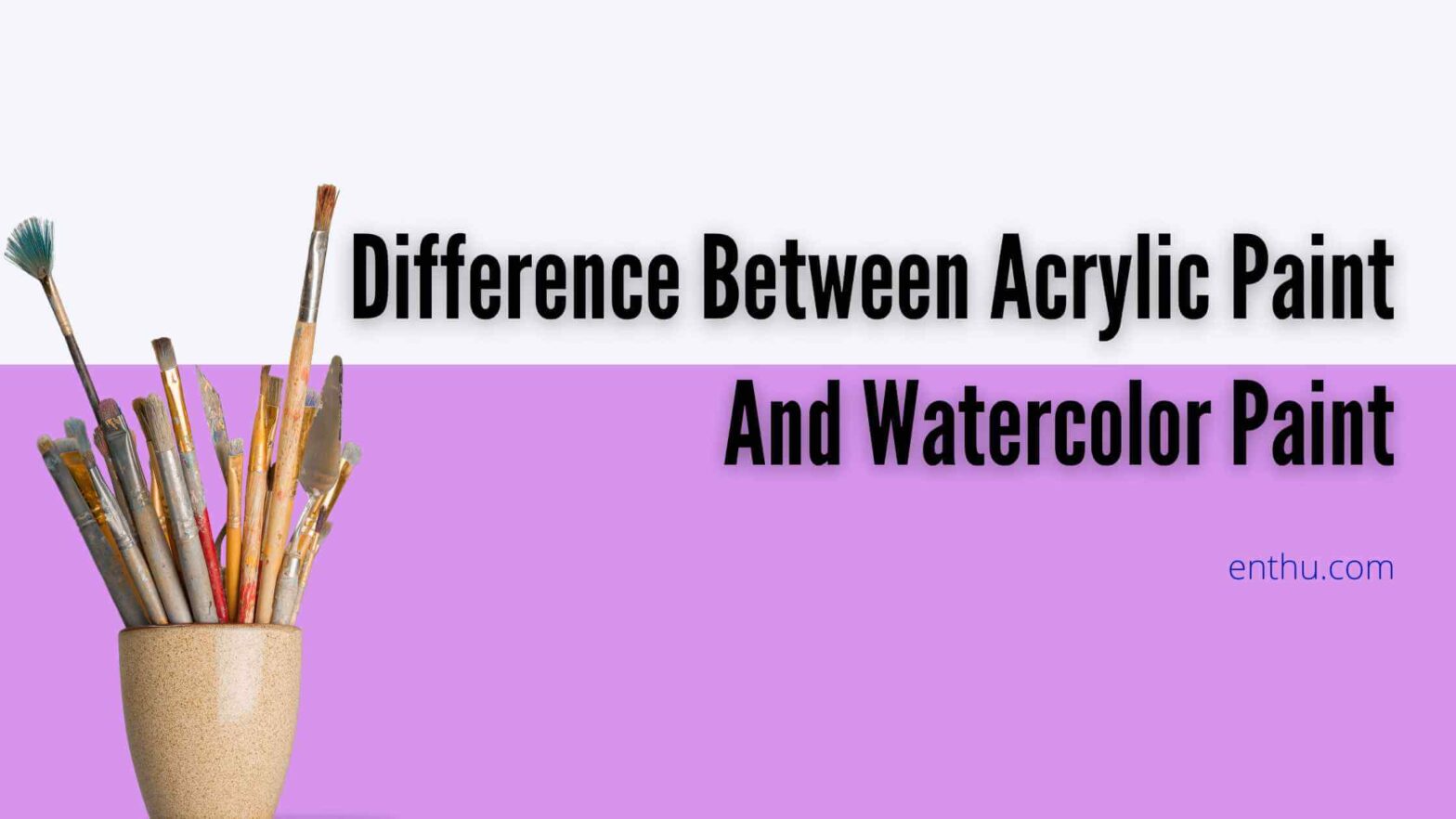Acrylic and watercolour are two popular paint types used in a variety of art forms. The main difference between acrylic paint and watercolour paint is the type of binder used.
Acrylic paint uses a synthetic polymer binder while water colour uses a water-soluble binder. Polymer binder makes acrylic paint ideal to use on a variety of surfaces, including canvas, paper, wood, and others. Water colour is great for painting on paper because it doesn’t form a waterproof layer and can be reactivated with water even after it’s dried.
Let’s check watercolour vs acrylic in detail.
Difference between Acrylic paint and Watercolor paint
| Property | Acrylic Paint | Watercolor Paint |
| Binder | Synthetic polymer binder | Water-soluble Binder |
| Drying Time | Dries more Slowly | Dries quickly |
| Layering | Layering as well as texture effects | Used in Layers |
| Dilution | Water ,Medium | Water |
| Coverage | High Coverage | Low Coverage |
| Flexibility | More Flexible | Less Flexible |
| Surface | Canvas,wood ,paper and more | Paper |
| Transparency | Opaque | Transparent |
| Clean up | Require solvent or soap | Easily clean with water |
| Colour Vibrancy | Bright and vivid colour | Fade overtime |
What are Acrylic Colours?

Acrylic color refers to a type of paint made with pigments suspended in a water-soluble acrylic polymer emulsion. This type of paint is known for its quick-drying properties and ability to be used on a variety of surfaces.
This is one of the salient differences between acrylic paint and watercolor paint. And this quick drying property make acrylic paint ideal to use on canvas, paper, wood, and even metal or plastic.
Acrylic colours come in a wide range of colours, from opaque to transparent, and can be thinned with water or mediums to achieve different effects. They are often used by artists, hobbyists, and craftspeople for a variety of projects.
Characteristics of Acrylic Colours
1. Quick-drying
Acrylic paint dries quickly, which allows artists to work faster and add layers without having to wait for long drying times.
2. Water-soluble
Acrylic paints are water-soluble, which means that they can be thinned with water to create a variety of effects, from thin washes to thick impasto textures.
3. Versatile
Acrylic paint can be used on a variety of surfaces, including canvas, paper, wood, metal, and even plastic.
4. Permanent
Once acrylic paint is dry, it becomes water-resistant and durable, making it ideal for outdoor use and other applications where the paint will be exposed to moisture.
5. Opaque or Transparent
Acrylic paints can be purchased in both opaque and transparent forms, which allows artists to choose the level of transparency or opacity they want for their work.
6. Range of Colours
Acrylic paints come in a wide range of colours, including vibrant hues and subtle tones, which allows artists to create a wide variety of effects and moods in their work.
What is Watercolour Paint?
Watercolor refers to a type of paint made from a mixture of pigments and water-soluble binders that are used to create art on paper or other absorbent surfaces.
Watercolour paint is known for its transparency and the way the colours blend together seamlessly when water is applied to the paint. Watercolour painting techniques can range from delicate washes to bold and expressive brushstrokes.
The medium is often used by artists to create landscapes, portraits, and still-life compositions.
Watercolour painting requires a certain level of skill and control to achieve the desired effects, and many artists enjoy the medium for its unpredictability and unique characteristics.
Characteristics of Watercolor Paint
1. Transparency
Watercolour paint is known for its transparency, which allows the colours to be layered and blended to create depth and dimension in the artwork.
2. Fluidity
Watercolour paint is designed to be used with water, which makes it highly fluid and allows the artist to create a wide range of effects, from delicate washes to bold, textured brush strokes.
3. Staining properties
Some watercolour pigments have staining properties, which means that they soak into the paper and are difficult to lift or remove once they have dried.
4. Granulation
Some watercolour pigments have granulating properties, which means that they separate and settle into the paper unevenly, creating a textured, grainy effect.
5. Lightfastness
Watercolour paints vary in their lightfastness, which is the degree to which they resist fading when exposed to light over time.
6. Versatility
Watercolour paint can be used on a variety of surfaces, including paper, canvas, and even wood, and can be mixed with other mediums, such as ink or gouache, to create unique effects.
In summary, acrylic paint is a versatile and opaque medium that dries quickly and forms a waterproof layer, while watercolour paint is translucent and water-soluble, making it ideal for delicate artwork and creating washes and gradients.
FAQs
Which is better for beginners watercolour or acrylic?
Both have their advantages, but watercolour is easier to start with because it requires fewer materials and has a simpler technique.
Is watercolour paint the same as acrylic paint?
No, watercolour is transparent and applied in thin layers with water, while acrylic is opaque and applied in thick layers without water.
Can you add water to acrylic paint?
Yes, adding water to acrylic paint can thin it out and create different effects, but dding too much water can weaken its properties.
Is acrylic paint washable?
Yes, acrylic paint is water-resistant when dry, making it washable and easy to clean with soap and water.
Conclusion
Overall, both watercolour and acrylic paint are popular and versatile mediums used in various art forms, and each has its own unique characteristics and strengths.
Choosing the right type of paint depends on the artist’s preferences and the desired effect they want to achieve in their artwork. Knowing differences between acrylic and watercolor paint will help artists make that decision.

